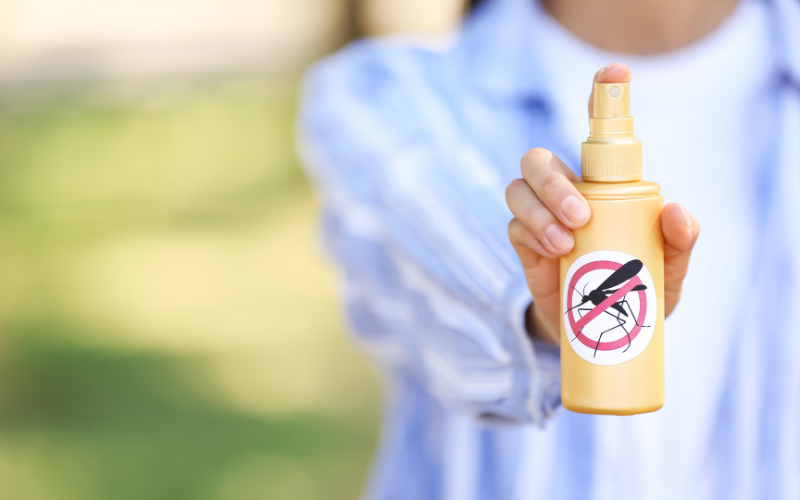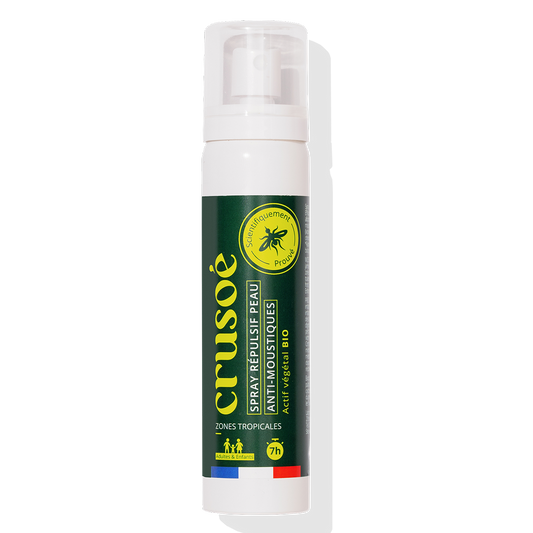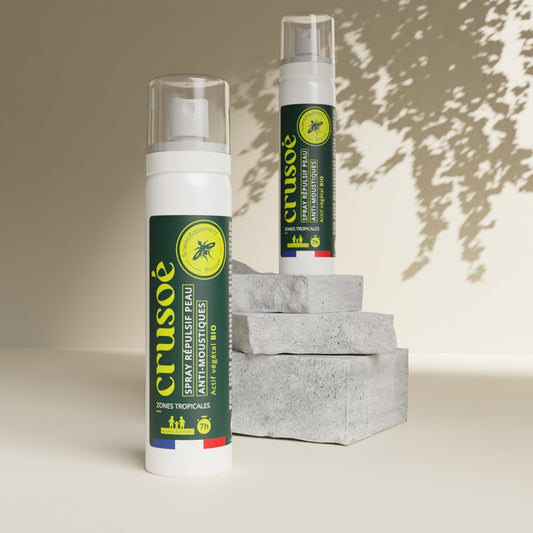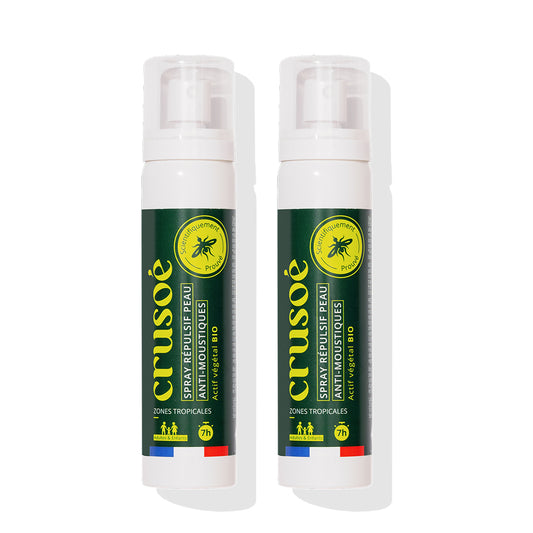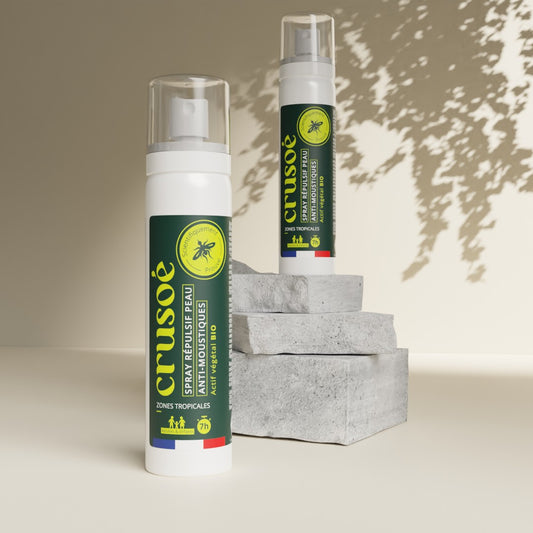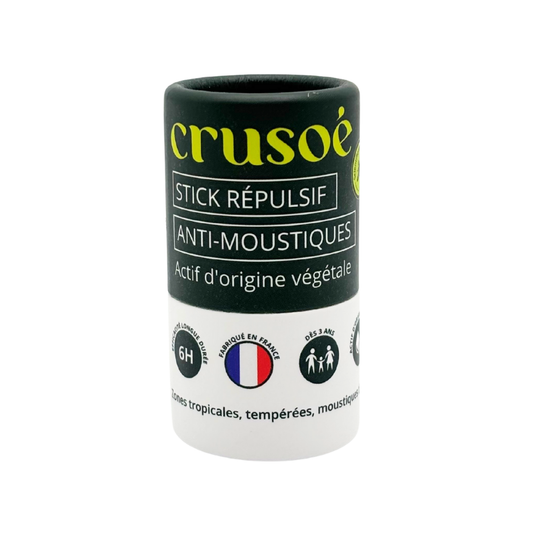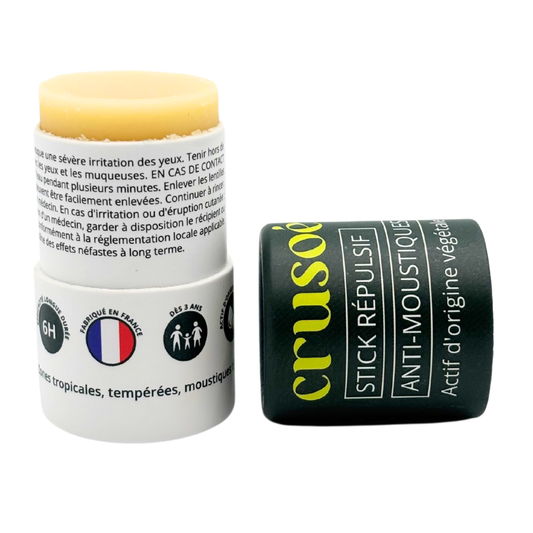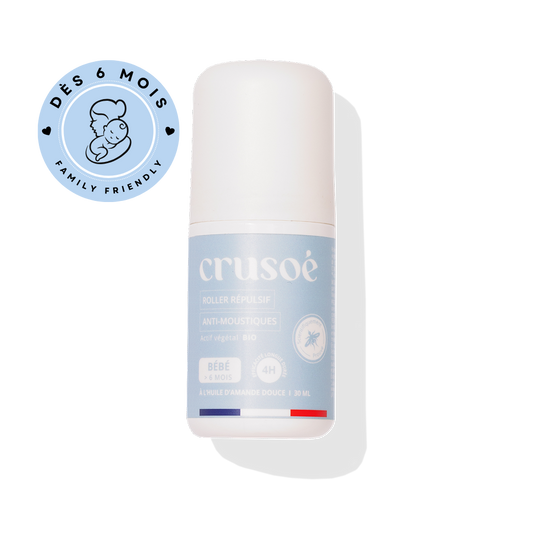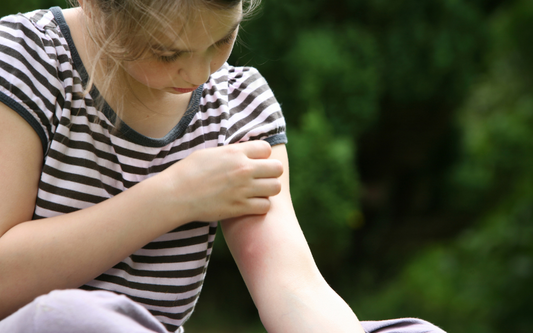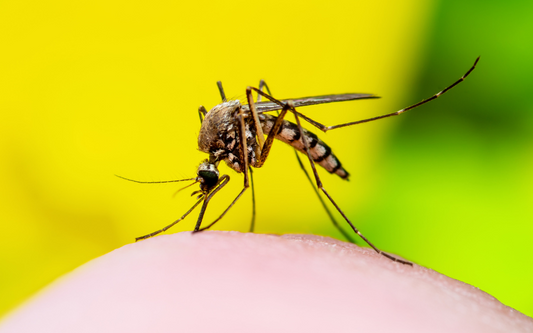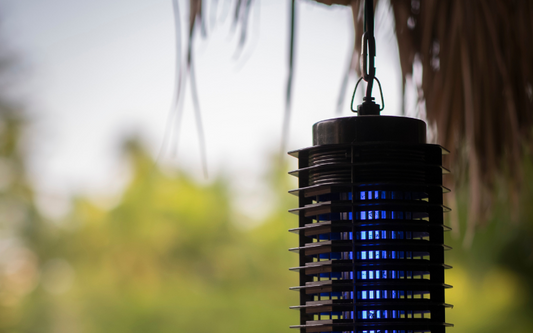N,N-diethyl-3-methylbenzamide or DEET is the active ingredient in the most widely used mosquito repellents in the world. It is a synthetic molecule, i.e. not natural and prepared chemically.
DEET has long been considered the gold standard for mosquito repellents. Historically, it was developed by the US military and was used in particular during the Vietnam War. Today, its effectiveness is still hard to beat: a 20% DEET solution provides approximately 8 hours of protection against Aedes albopictus, the tiger mosquito.1

However, its side effects on human health and the environment are often discussed and are still debated within the scientific community. Indeed, although it has been used for over 50 years, the molecular mode of action of DEET has not yet been completely elucidated. DEET disrupts the olfactory and taste systems of mosquitoes, repelling them and/or masking the host's attractive molecules. 2 However, DEET also acts on the nervous system of mosquitoes and prevents their neurons from functioning normally . Some confusion persists today about the type of targets of DEET in the nervous system of mosquitoes, but it is clear that it can present a real neurotoxic effect for mosquitoes.[*] DEET affects in particular the mosquito's locomotor system and a few micrograms can even lead to its death within 24 hours. 7
[*] It now appears that acetylcholinesterase is not one of DEET's preferred targets. 3.4 but it would rather target octopaminergic receptors and muscarinic M1/M3 mAchR receptors. 5,6
How does DEET affect mosquitoes compared to other animals, especially humans?
Scientists all agree on one thing: DEET is a molecule irritating to the skin and mucous membranes , and a single application can be enough to cause an allergic reaction . 7.8 In fact, this molecule is capable of degrading plastic and synthetic fibers . 9
However, in the absence of direct evidence of DEET toxicity in humans, disagreements persist. Although about twenty cases of encephalopathy have been reported by doctors in young children after cutaneous application of DEET-based repellents, 10 some researchers assume that this is simply a coincidence. 8,11 In 2001, a brief clinical study on pregnant women in Thailand, half of whom applied a DEET-based repellent daily, did not show any difference in growth between newborns, up to one year of age. 12 However, no data on the cognitive development of children have been carried out, especially since several studies have shown that DEET has been found in the placenta of mothers . 8 In addition, a lack of long-term clinical studies does not allow conclusions to be drawn as to the safety of this molecule.
.png)
More recent studies at the cellular level have shown that DEET can act on numerous targets in the central and peripheral nervous system of mammals and therefore would not spare humans. 7 DEET would also have a pro-angiogenic effect, that is to say that it would stimulate the proliferation, migration and adhesion of endothelial cells involved in the growth of tumors . 6
In addition to showing worrying signs of toxicity to humans, DEET-based repellents have a negative impact on the environment . Indeed, DEET being a non-natural molecule, and its preparation therefore requires chemical synthesis . However, this chemical preparation relies on the use of dangerous reagents and generating numerous polluting waste .
Additionally, several strains of mosquitoes used in laboratory repellent tests have shown some resistance to DEET . This resistance may be due to a mosquito learning phenomenon when faced with DEET. Nearly half of female mosquitoes of the species Aedes aegypti, cousin of the tiger mosquito, already exposed to DEET for the first time, become less sensitive to it. 13 This resistance can also have a genetic origin and lead to total insensitivity. This type of genetic resistance can then be transmitted to the mosquito's offspring and spread selectively within the population. 14 This phenomenon has not yet been observed in nature, but ANSES is already recommending a rational use of DEET in order to avoid the spontaneous appearance of new strains resistant to DEET.
Claire Grison - Biochemistry Engineer, Doctor of Organic Chemistry and Scientific Editor
References:
[1] E. Lupi, C. Hatz and P. Schlagenhauf, Travel Medicine and Infectious Disease, 2013, 11, 374–411. (no more recent publications were found on the effectiveness of DEET)
[2] B. Shrestha and Y. Lee, Genes Genomics , 2020, 42, 1131–1144.
[3] V. Corbel, M. Stankiewicz, C. Pennetier, D. Fournier, J. Stojan, E. Girard, M. Dimitrov, J. Molgó, J.-M. Hougard and B. Lapied, BMC Bio l, 2009, 7, 47.
[4] DR Swale, B. Sun, F. Tong and JR Bloomquist, PLoS One , 2014, 9, e103713.
[5] A. Abd-Ella, M. Stankiewicz, K. Mikulska, W. Nowak, C. Pennetier, M. Goulu, C. Fruchart-Gaillard, P. Licznar, V. Apaire-Marchais, O. List, V . Corbel, D. Servent and B. Lapied, PLoS ONE, 2015, 10, e0126406.
[6] S. Legeay, N. Clere, G. Hilairet, Q.-T. Do, P. Bernard, J.-F. Quignard, V. Apaire-Marchais, B. Lapied and S. Faure, Sci Rep , 2016, 6, 28546.
[7] S. Legeay, N. Clere, V. Apaire-Marchais, S. Faure and B. Lapied, European Journal of Pharmacology , 2018, 825, 92–98.
[8] V. Chen-Hussey, R. Behrens and JG Logan, Parasites & Vectors , 2014, 7, 173.
[9] JH Diaz, Wilderness Environ Med , 2016, 27, 153–163.
[10] G. Briassoulis, M. Narlioglou and T. Hatzis, Hum Exp Toxicol , 2001, 20, 8–14.
[11] G. Koren, D. Matsui and B. Bailey, CMAJ , 2003, 169, 209–212.
[12] R. McGready, KA Hamilton, JA Simpson, T. Cho, C. Luxemburger, R. Edwards, S. Looareesuwan, NJ White, F. Nosten and SW Lindsay, Am J Trop Med Hyg , 2001, 65, 285–289.
[13] NM Stanczyk, JFY Brookfield, LM Field and JG Logan, PLOS ONE , 2013, 8, e54438.
[14] NM Stanczyk, JFY Brookfield, R. Ignell, JG Logan and LM Field, PNAS , 2010, 107, 8575–8580.

